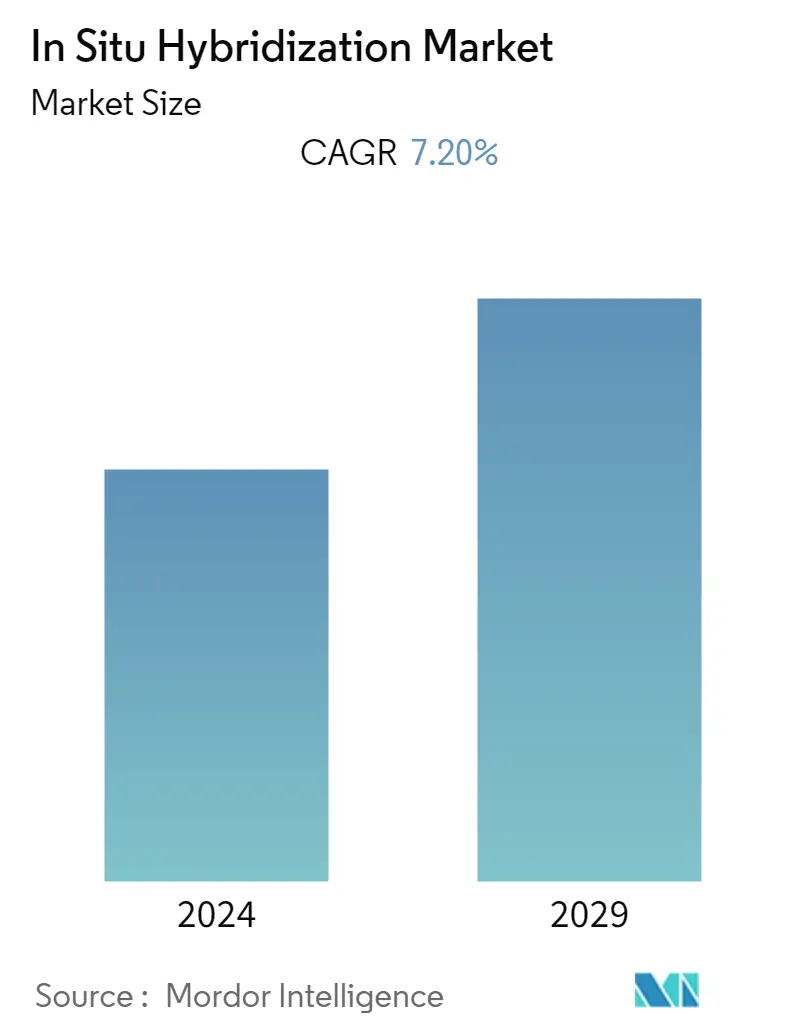Market Size of In Situ Hybridization Industry

| Study Period | 2021 - 2029 |
| Base Year For Estimation | 2023 |
| Forecast Data Period | 2024 - 2029 |
| CAGR | 7.20 % |
| Fastest Growing Market | Asia Pacific |
| Largest Market | North America |
Major Players
*Disclaimer: Major Players sorted in no particular order |
In-Situ Hybridization Market Analysis
The In Situ Hybridization Market studied is expected to register with an anticipated CAGR of 7.2% during the forecast period.
The COVID-19 pandemic is expected to have a significant effect on the market. To keep pace with increased testing norms to detect suspected cases of COVID-19, with the emergence of the SARS-CoV-2 virus, already increased lab testing demand grew even more across the world. For instance, the article published in Nature Journal in October 2021 mentioned that a rapid fluorescence in situ hybridization protocol capable of detecting SARS-CoV-2 specifically and quantitatively in approximately 20 minutes in virus cultures combined nasal and throat swabs with added virus and likely patient samples with added virus and likely patient samples without previous purifications. Such proven efficacy of in situ hybridizations in the diagnosis of COVID-19 infection significantly impacted the market growth during the pandemic period. Also, the demand for in situ hybridization is expected to remain intact due to the emergence of various mutant strains of the SARS-CoV-2 virus during the post-pandemic period, thereby driving the growth of the market during the forecast period.
The increasing incidence of cancer, infectious diseases, and genetic disorders and the growing awareness of cancer therapeutics are the major drivers for the growth of the in-situ hybridization market. For instance, the Global Flu data published in February 2022 mentioned that an estimated 1 billion people worldwide are infected by seasonal influenza yearly. The report also mentioned that out of those 1 billion, about 3 to 5 million people have a severe case of flu every year. Likewise, the report published by the World Health Organization in November 2021 reported that more than 1.0 million sexually transmitted infections are acquired globally, and most of them are asymptomatic. It also reported that every year there are an estimated 374.0 million new infections, with 1 out of 4 sexually transmitted infections: gonorrhea, chlamydia, trichomoniasis, and syphilis.
Additionally, as per the WHO factsheet published in February 2022, in 2021, there were an estimated 1.9 million new cancer cases diagnosed in the United States. The report also mentioned that each year, approximately 400,000 children develop cancer globally. Cervical cancer is the most common in 23 countries, such as Eswatini, India, South Africa, Latin America, and others. The most common cancers are breast, lung, colon, rectum, and prostate. Such rising cases of infectious diseases and cancer across the world are expected to drive the demand for advanced and effective diagnosis, thereby contributing to the growth of the market over the forecast period.
Additionally, the rising market players' initiatives, such as partnerships, acquisitions, and mergers to develop in situ hybridization techniques, are also expected to propel the market's growth. For instance, in March 2021, Bio SB announced that through its partnership agreement with ZytoVision, it would distribute a line of CE-approved chromogenic in situ hybridization and fluorescent in situ hybridization probes targeted for use in lung carcinomas.
However, the lack of skilled professionals to perform advanced procedures is expected to restrain the market's growth over the forecast period.
In-Situ Hybridization Industry Segmentation
As per the scope of the report, it is a technique that allows precise localization of a specific segment of nucleic acid within a histologic section. It is a laboratory technique to localize a sequence of DNA or RNA in a biological sample.
The In Situ Hybridization Market is segmented by Product (Analytical Instruments, Kits and Reagents, Software and Services, and Other Products), Technique (Fluorescence In Situ Hybridization(FISH), and Chromogenic In Situ Hybridization(CISH)), Application (Cancer, Infectious Diseases, and Other Applications), End User (Diagnostics Laboratories, Academic and Research Institutions, and Contract Research Organizations (CROs)), and Geography (North America, Europe, Asia-Pacific, Middle-East and Africa, and South America). The market report also covers the estimated market sizes and trends for 17 different countries across major regions globally. The report offers the value (in USD million) for the above segments.
| By Product | |
| Analytical Instruments | |
| Kits and Reagents | |
| Software and Services | |
| Other Products |
| By Technique | |
| Fluoresence In Situ Hybridization (FISH) | |
| Chromogenic In Situ hybridization (CISH) |
| By Application | |
| Cancer | |
| Infectious Diseases | |
| Others |
| By End User | |
| Diagnostics Laboratories | |
| Academic and Research Institutions | |
| Contract Research Organizations (CROs) |
| Geography | ||||||||
| ||||||||
| ||||||||
| ||||||||
| ||||||||
|
In Situ Hybridization Market Size Summary
The in situ hybridization market is poised for significant growth, driven by the increasing incidence of cancer, infectious diseases, and genetic disorders. The market is expected to expand at a robust pace over the forecast period, with the COVID-19 pandemic acting as a catalyst for its development. The demand for in situ hybridization techniques surged during the pandemic due to their efficacy in diagnosing COVID-19, and this trend is anticipated to continue with the emergence of various mutant strains. The market's expansion is further supported by the rising awareness of cancer therapeutics and the need for advanced diagnostic procedures. The Fluorescence In Situ Hybridization (FISH) segment, in particular, is expected to benefit from the growing prevalence of chromosomal disorders and chronic diseases, as well as the increasing demand for efficient diagnostic methods.
North America is projected to hold a dominant position in the in situ hybridization market, attributed to the high incidence of cancer and the prevalence of infectious diseases and genetic disorders in the region. The presence of key market players, coupled with frequent product launches and robust research and development activities, is expected to bolster market growth. The competitive landscape of the market is characterized by the presence of major players such as Abnova Corporation, Agilent Technologies Inc., and Thermo Fisher Scientific Inc., among others. These companies are actively engaged in strategic initiatives like partnerships and product launches to enhance their market offerings. Despite the promising growth prospects, the market faces challenges, including a shortage of skilled professionals to perform advanced procedures, which may hinder its expansion.
In Situ Hybridization Market Size - Table of Contents
-
1. MARKET DYNAMICS
-
1.1 Market Overview
-
1.2 Market Drivers
-
1.2.1 Increasing Prevalence of Cancer, Infectious Diseases and Genetic Disorders
-
1.2.2 Advancements in Diagnostic Tools
-
1.2.3 Rising Awareness on Cancer Therapeutics
-
-
1.3 Market Restraints
-
1.3.1 Lack of Skilled Personnel
-
-
1.4 Porter's Five Force Analysis
-
1.4.1 Threat of New Entrants
-
1.4.2 Bargaining Power of Buyers/Consumers
-
1.4.3 Bargaining Power of Suppliers
-
1.4.4 Threat of Substitute Products
-
1.4.5 Intensity of Competitive Rivalry
-
-
-
2. MARKET SEGMENTATION (Market Size by Value - USD Million)
-
2.1 By Product
-
2.1.1 Analytical Instruments
-
2.1.2 Kits and Reagents
-
2.1.3 Software and Services
-
2.1.4 Other Products
-
-
2.2 By Technique
-
2.2.1 Fluoresence In Situ Hybridization (FISH)
-
2.2.2 Chromogenic In Situ hybridization (CISH)
-
-
2.3 By Application
-
2.3.1 Cancer
-
2.3.2 Infectious Diseases
-
2.3.3 Others
-
-
2.4 By End User
-
2.4.1 Diagnostics Laboratories
-
2.4.2 Academic and Research Institutions
-
2.4.3 Contract Research Organizations (CROs)
-
-
2.5 Geography
-
2.5.1 North America
-
2.5.1.1 United States
-
2.5.1.2 Canada
-
2.5.1.3 Mexico
-
-
2.5.2 Europe
-
2.5.2.1 Germany
-
2.5.2.2 United Kingdom
-
2.5.2.3 France
-
2.5.2.4 Italy
-
2.5.2.5 Spain
-
2.5.2.6 Rest of Europe
-
-
2.5.3 Asia-Pacific
-
2.5.3.1 China
-
2.5.3.2 Japan
-
2.5.3.3 India
-
2.5.3.4 Australia
-
2.5.3.5 South Korea
-
2.5.3.6 Rest of Asia-Pacific
-
-
2.5.4 Middle-East and Africa
-
2.5.4.1 GCC
-
2.5.4.2 South Africa
-
2.5.4.3 Rest of Middle-East and Africa
-
-
2.5.5 South America
-
2.5.5.1 Brazil
-
2.5.5.2 Argentina
-
2.5.5.3 Rest of South America
-
-
-
In Situ Hybridization Market Size FAQs
What is the current In Situ Hybridization Market size?
The In Situ Hybridization Market is projected to register a CAGR of 7.20% during the forecast period (2024-2029)
Who are the key players in In Situ Hybridization Market?
Agilent Technologies,Inc. , Biocare Medical,LLC. , F. Hoffmann-La Roche Ltd., Genemed Biotechnologies, Inc. and Thermo Fisher Scientific are the major companies operating in the In Situ Hybridization Market.

